SWM518 Health Economics and Finance: Health Care Expenditure Growth
VerifiedAdded on 2022/11/27
|16
|4033
|257
Essay
AI Summary
This essay provides an analysis of health care expenditure growth and its key drivers. It begins by highlighting the rapid increase in government spending on healthcare over the past four decades, emphasizing the rising proportion of total spending allocated to this sector globally. The essay explores various factors contributing to this growth, including population aging, increased life expectancy, unhealthy lifestyles, and the prevalence of diseases such as diabetes, cancer, and cardiovascular issues. It examines the correlation between GDP per capita and healthcare expenditure, noting the impact of income on healthcare spending. The essay further discusses the trends in healthcare expenditure across different countries, with a specific focus on the United States, Australia, and Germany, and the impact of income and population growth. It also delves into the policy implications of rising healthcare costs, particularly concerning affordability at both individual and national levels. The document references various sources and data to support its arguments, offering a comprehensive overview of the economic dynamics of healthcare expenditure.
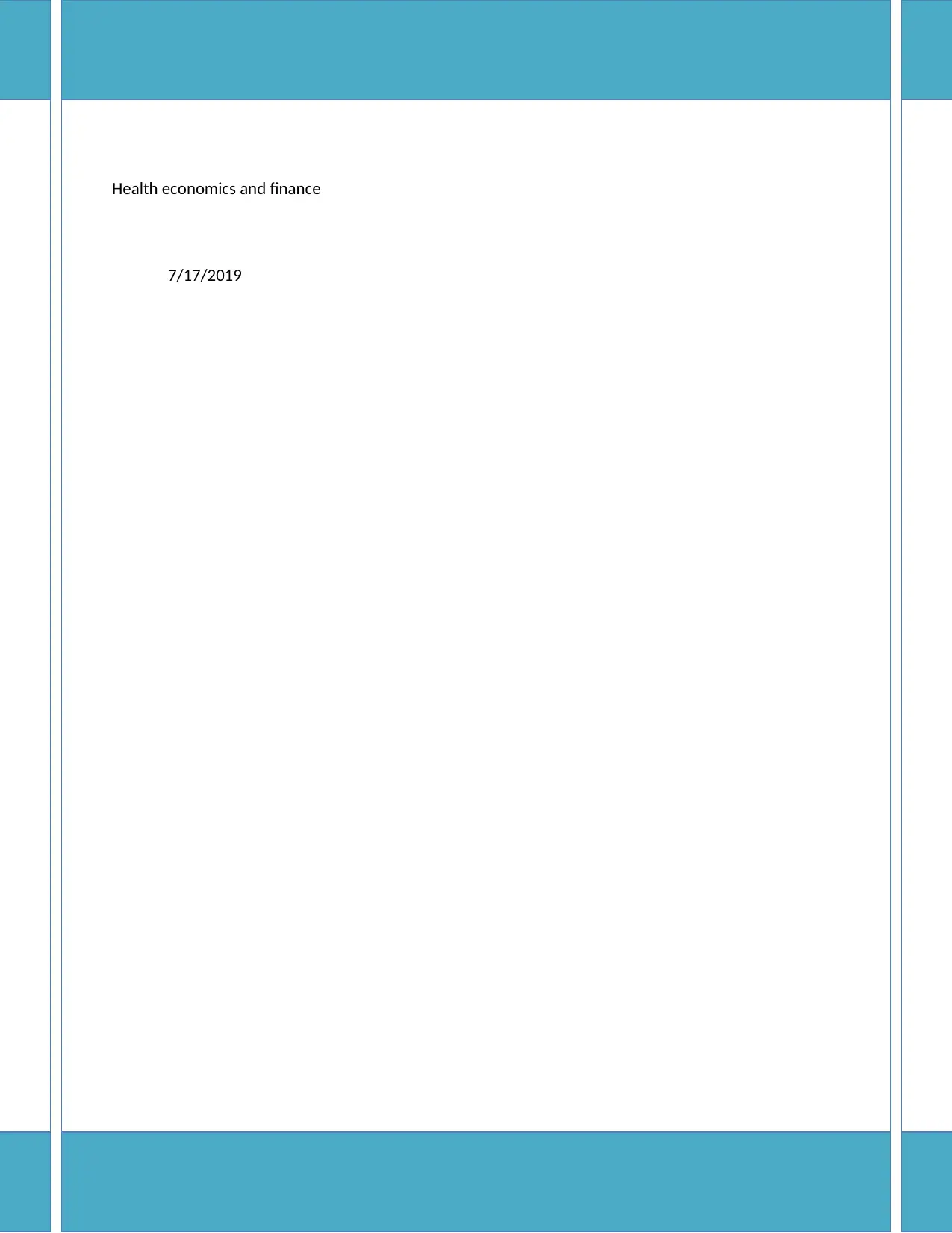
Health economics and finance
7/17/2019
7/17/2019
Paraphrase This Document
Need a fresh take? Get an instant paraphrase of this document with our AI Paraphraser
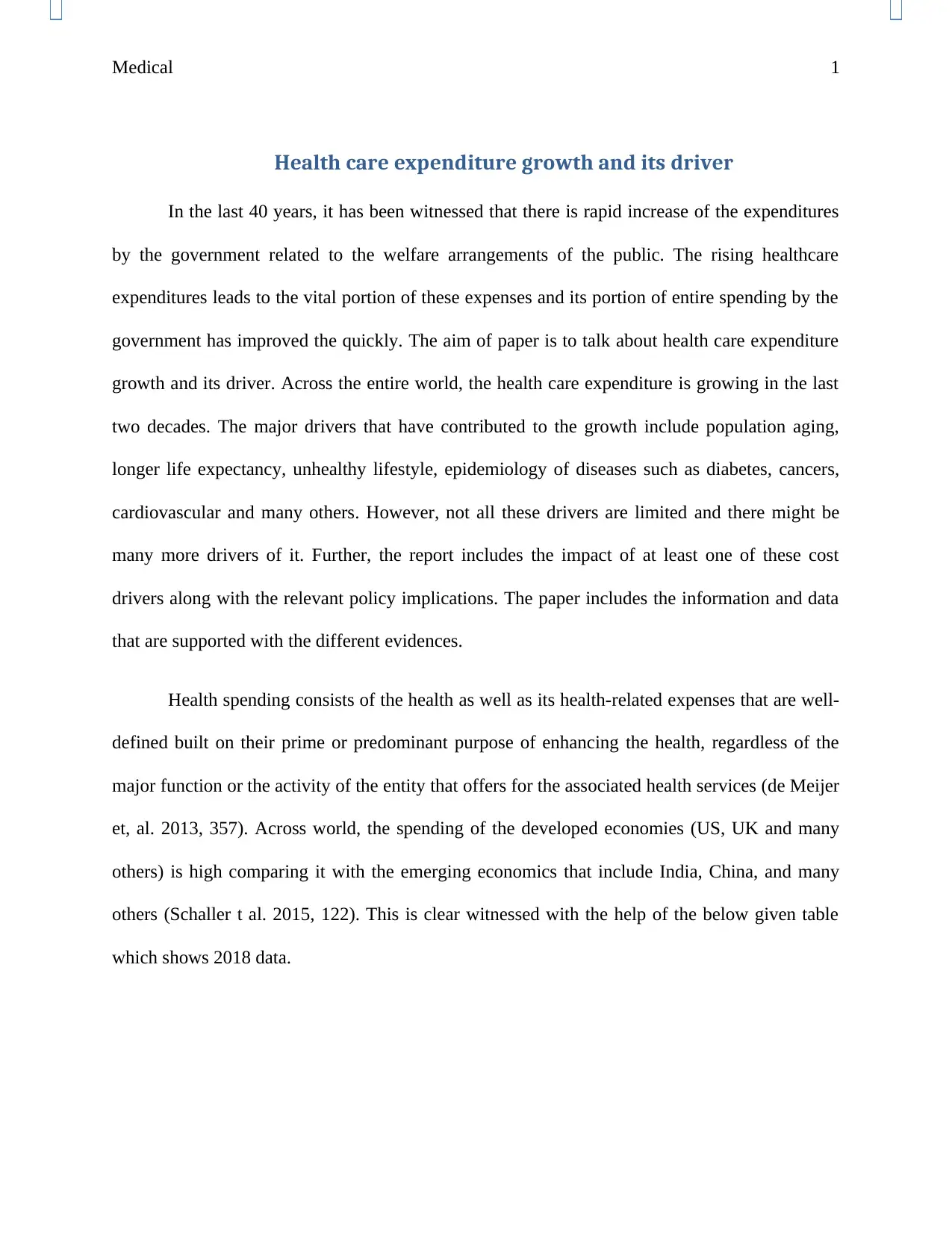
Medical 1
Health care expenditure growth and its driver
In the last 40 years, it has been witnessed that there is rapid increase of the expenditures
by the government related to the welfare arrangements of the public. The rising healthcare
expenditures leads to the vital portion of these expenses and its portion of entire spending by the
government has improved the quickly. The aim of paper is to talk about health care expenditure
growth and its driver. Across the entire world, the health care expenditure is growing in the last
two decades. The major drivers that have contributed to the growth include population aging,
longer life expectancy, unhealthy lifestyle, epidemiology of diseases such as diabetes, cancers,
cardiovascular and many others. However, not all these drivers are limited and there might be
many more drivers of it. Further, the report includes the impact of at least one of these cost
drivers along with the relevant policy implications. The paper includes the information and data
that are supported with the different evidences.
Health spending consists of the health as well as its health-related expenses that are well-
defined built on their prime or predominant purpose of enhancing the health, regardless of the
major function or the activity of the entity that offers for the associated health services (de Meijer
et, al. 2013, 357). Across world, the spending of the developed economies (US, UK and many
others) is high comparing it with the emerging economics that include India, China, and many
others (Schaller t al. 2015, 122). This is clear witnessed with the help of the below given table
which shows 2018 data.
Health care expenditure growth and its driver
In the last 40 years, it has been witnessed that there is rapid increase of the expenditures
by the government related to the welfare arrangements of the public. The rising healthcare
expenditures leads to the vital portion of these expenses and its portion of entire spending by the
government has improved the quickly. The aim of paper is to talk about health care expenditure
growth and its driver. Across the entire world, the health care expenditure is growing in the last
two decades. The major drivers that have contributed to the growth include population aging,
longer life expectancy, unhealthy lifestyle, epidemiology of diseases such as diabetes, cancers,
cardiovascular and many others. However, not all these drivers are limited and there might be
many more drivers of it. Further, the report includes the impact of at least one of these cost
drivers along with the relevant policy implications. The paper includes the information and data
that are supported with the different evidences.
Health spending consists of the health as well as its health-related expenses that are well-
defined built on their prime or predominant purpose of enhancing the health, regardless of the
major function or the activity of the entity that offers for the associated health services (de Meijer
et, al. 2013, 357). Across world, the spending of the developed economies (US, UK and many
others) is high comparing it with the emerging economics that include India, China, and many
others (Schaller t al. 2015, 122). This is clear witnessed with the help of the below given table
which shows 2018 data.
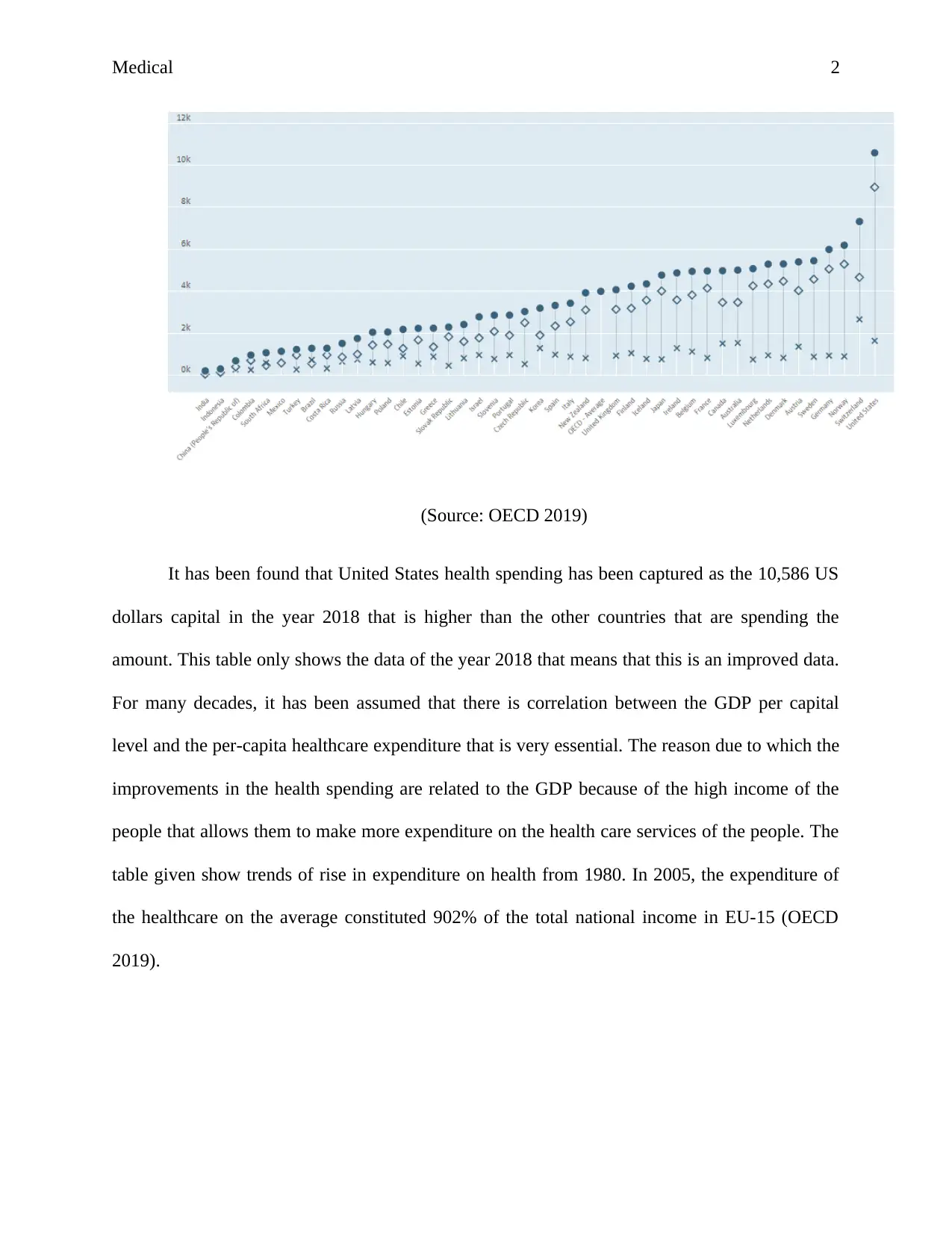
Medical 2
(Source: OECD 2019)
It has been found that United States health spending has been captured as the 10,586 US
dollars capital in the year 2018 that is higher than the other countries that are spending the
amount. This table only shows the data of the year 2018 that means that this is an improved data.
For many decades, it has been assumed that there is correlation between the GDP per capital
level and the per-capita healthcare expenditure that is very essential. The reason due to which the
improvements in the health spending are related to the GDP because of the high income of the
people that allows them to make more expenditure on the health care services of the people. The
table given show trends of rise in expenditure on health from 1980. In 2005, the expenditure of
the healthcare on the average constituted 902% of the total national income in EU-15 (OECD
2019).
(Source: OECD 2019)
It has been found that United States health spending has been captured as the 10,586 US
dollars capital in the year 2018 that is higher than the other countries that are spending the
amount. This table only shows the data of the year 2018 that means that this is an improved data.
For many decades, it has been assumed that there is correlation between the GDP per capital
level and the per-capita healthcare expenditure that is very essential. The reason due to which the
improvements in the health spending are related to the GDP because of the high income of the
people that allows them to make more expenditure on the health care services of the people. The
table given show trends of rise in expenditure on health from 1980. In 2005, the expenditure of
the healthcare on the average constituted 902% of the total national income in EU-15 (OECD
2019).
⊘ This is a preview!⊘
Do you want full access?
Subscribe today to unlock all pages.

Trusted by 1+ million students worldwide
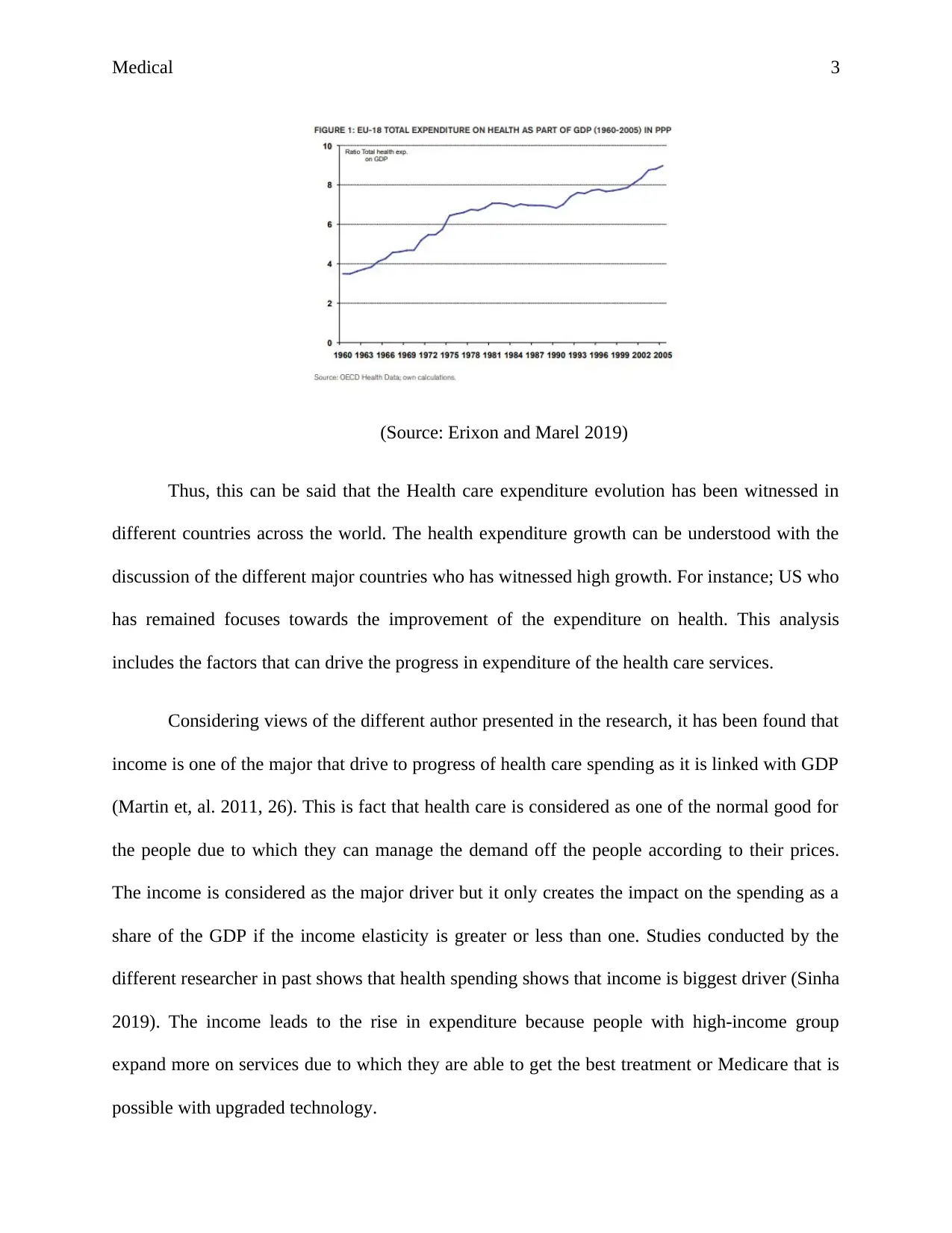
Medical 3
(Source: Erixon and Marel 2019)
Thus, this can be said that the Health care expenditure evolution has been witnessed in
different countries across the world. The health expenditure growth can be understood with the
discussion of the different major countries who has witnessed high growth. For instance; US who
has remained focuses towards the improvement of the expenditure on health. This analysis
includes the factors that can drive the progress in expenditure of the health care services.
Considering views of the different author presented in the research, it has been found that
income is one of the major that drive to progress of health care spending as it is linked with GDP
(Martin et, al. 2011, 26). This is fact that health care is considered as one of the normal good for
the people due to which they can manage the demand off the people according to their prices.
The income is considered as the major driver but it only creates the impact on the spending as a
share of the GDP if the income elasticity is greater or less than one. Studies conducted by the
different researcher in past shows that health spending shows that income is biggest driver (Sinha
2019). The income leads to the rise in expenditure because people with high-income group
expand more on services due to which they are able to get the best treatment or Medicare that is
possible with upgraded technology.
(Source: Erixon and Marel 2019)
Thus, this can be said that the Health care expenditure evolution has been witnessed in
different countries across the world. The health expenditure growth can be understood with the
discussion of the different major countries who has witnessed high growth. For instance; US who
has remained focuses towards the improvement of the expenditure on health. This analysis
includes the factors that can drive the progress in expenditure of the health care services.
Considering views of the different author presented in the research, it has been found that
income is one of the major that drive to progress of health care spending as it is linked with GDP
(Martin et, al. 2011, 26). This is fact that health care is considered as one of the normal good for
the people due to which they can manage the demand off the people according to their prices.
The income is considered as the major driver but it only creates the impact on the spending as a
share of the GDP if the income elasticity is greater or less than one. Studies conducted by the
different researcher in past shows that health spending shows that income is biggest driver (Sinha
2019). The income leads to the rise in expenditure because people with high-income group
expand more on services due to which they are able to get the best treatment or Medicare that is
possible with upgraded technology.
Paraphrase This Document
Need a fresh take? Get an instant paraphrase of this document with our AI Paraphraser
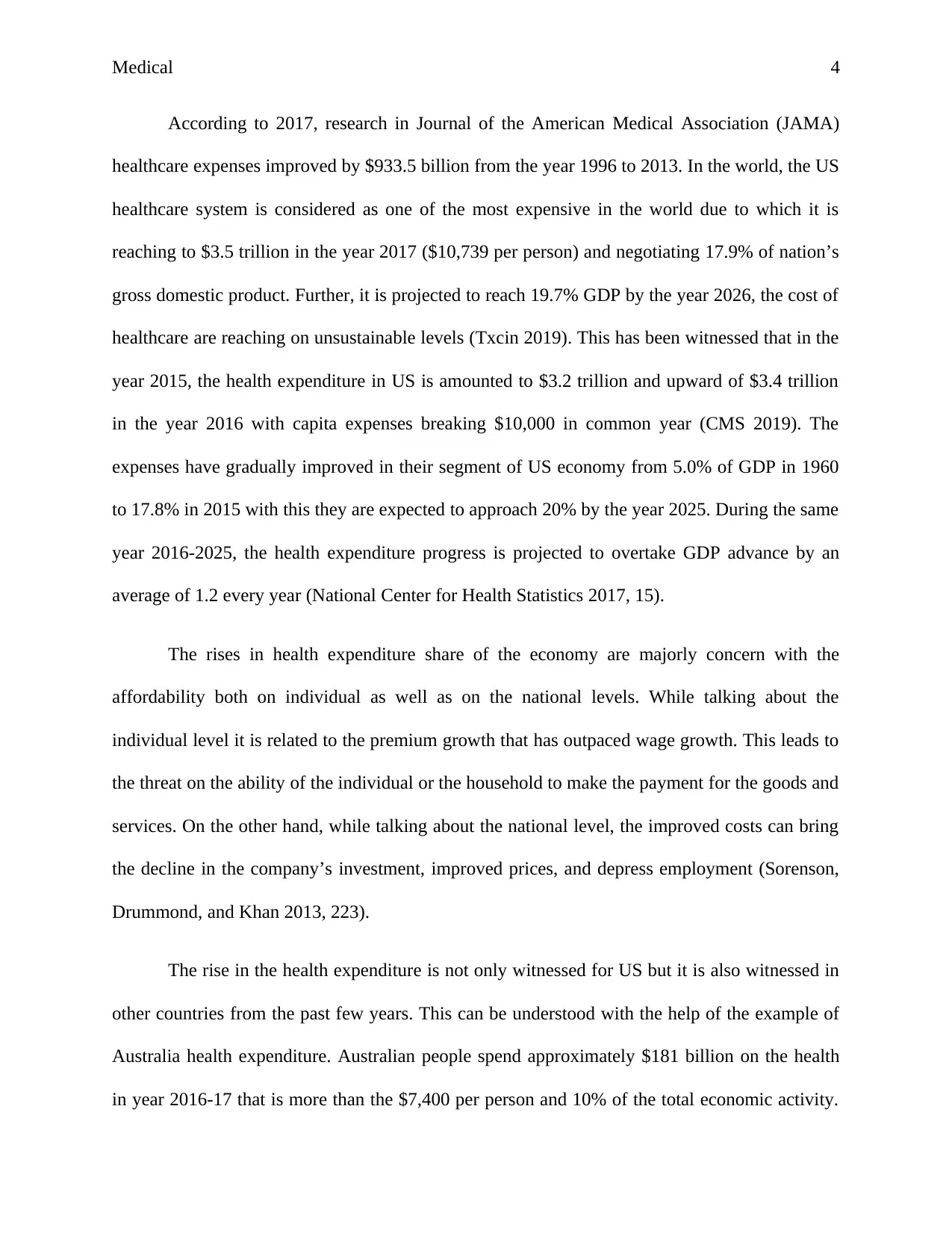
Medical 4
According to 2017, research in Journal of the American Medical Association (JAMA)
healthcare expenses improved by $933.5 billion from the year 1996 to 2013. In the world, the US
healthcare system is considered as one of the most expensive in the world due to which it is
reaching to $3.5 trillion in the year 2017 ($10,739 per person) and negotiating 17.9% of nation’s
gross domestic product. Further, it is projected to reach 19.7% GDP by the year 2026, the cost of
healthcare are reaching on unsustainable levels (Txcin 2019). This has been witnessed that in the
year 2015, the health expenditure in US is amounted to $3.2 trillion and upward of $3.4 trillion
in the year 2016 with capita expenses breaking $10,000 in common year (CMS 2019). The
expenses have gradually improved in their segment of US economy from 5.0% of GDP in 1960
to 17.8% in 2015 with this they are expected to approach 20% by the year 2025. During the same
year 2016-2025, the health expenditure progress is projected to overtake GDP advance by an
average of 1.2 every year (National Center for Health Statistics 2017, 15).
The rises in health expenditure share of the economy are majorly concern with the
affordability both on individual as well as on the national levels. While talking about the
individual level it is related to the premium growth that has outpaced wage growth. This leads to
the threat on the ability of the individual or the household to make the payment for the goods and
services. On the other hand, while talking about the national level, the improved costs can bring
the decline in the company’s investment, improved prices, and depress employment (Sorenson,
Drummond, and Khan 2013, 223).
The rise in the health expenditure is not only witnessed for US but it is also witnessed in
other countries from the past few years. This can be understood with the help of the example of
Australia health expenditure. Australian people spend approximately $181 billion on the health
in year 2016-17 that is more than the $7,400 per person and 10% of the total economic activity.
According to 2017, research in Journal of the American Medical Association (JAMA)
healthcare expenses improved by $933.5 billion from the year 1996 to 2013. In the world, the US
healthcare system is considered as one of the most expensive in the world due to which it is
reaching to $3.5 trillion in the year 2017 ($10,739 per person) and negotiating 17.9% of nation’s
gross domestic product. Further, it is projected to reach 19.7% GDP by the year 2026, the cost of
healthcare are reaching on unsustainable levels (Txcin 2019). This has been witnessed that in the
year 2015, the health expenditure in US is amounted to $3.2 trillion and upward of $3.4 trillion
in the year 2016 with capita expenses breaking $10,000 in common year (CMS 2019). The
expenses have gradually improved in their segment of US economy from 5.0% of GDP in 1960
to 17.8% in 2015 with this they are expected to approach 20% by the year 2025. During the same
year 2016-2025, the health expenditure progress is projected to overtake GDP advance by an
average of 1.2 every year (National Center for Health Statistics 2017, 15).
The rises in health expenditure share of the economy are majorly concern with the
affordability both on individual as well as on the national levels. While talking about the
individual level it is related to the premium growth that has outpaced wage growth. This leads to
the threat on the ability of the individual or the household to make the payment for the goods and
services. On the other hand, while talking about the national level, the improved costs can bring
the decline in the company’s investment, improved prices, and depress employment (Sorenson,
Drummond, and Khan 2013, 223).
The rise in the health expenditure is not only witnessed for US but it is also witnessed in
other countries from the past few years. This can be understood with the help of the example of
Australia health expenditure. Australian people spend approximately $181 billion on the health
in year 2016-17 that is more than the $7,400 per person and 10% of the total economic activity.
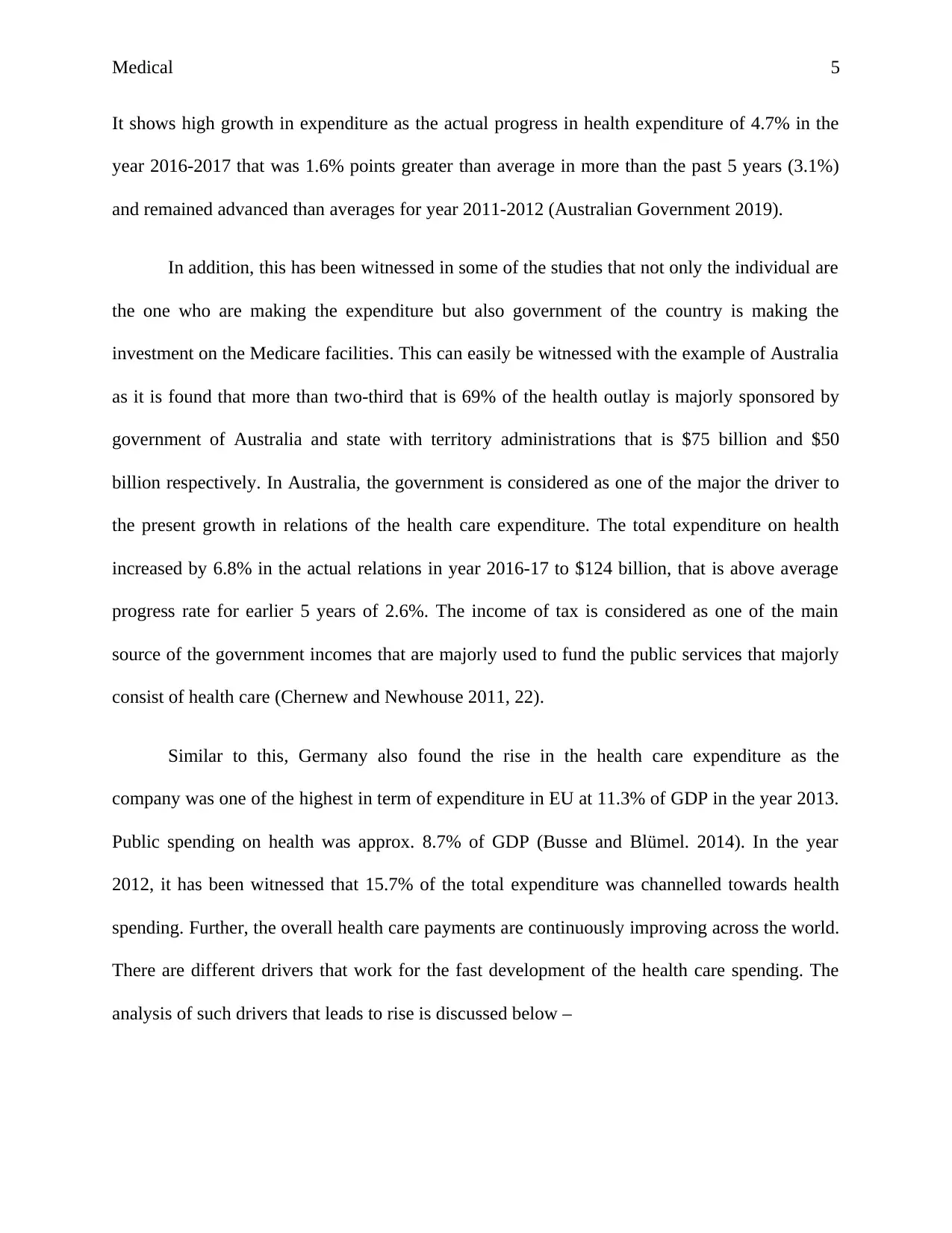
Medical 5
It shows high growth in expenditure as the actual progress in health expenditure of 4.7% in the
year 2016-2017 that was 1.6% points greater than average in more than the past 5 years (3.1%)
and remained advanced than averages for year 2011-2012 (Australian Government 2019).
In addition, this has been witnessed in some of the studies that not only the individual are
the one who are making the expenditure but also government of the country is making the
investment on the Medicare facilities. This can easily be witnessed with the example of Australia
as it is found that more than two-third that is 69% of the health outlay is majorly sponsored by
government of Australia and state with territory administrations that is $75 billion and $50
billion respectively. In Australia, the government is considered as one of the major the driver to
the present growth in relations of the health care expenditure. The total expenditure on health
increased by 6.8% in the actual relations in year 2016-17 to $124 billion, that is above average
progress rate for earlier 5 years of 2.6%. The income of tax is considered as one of the main
source of the government incomes that are majorly used to fund the public services that majorly
consist of health care (Chernew and Newhouse 2011, 22).
Similar to this, Germany also found the rise in the health care expenditure as the
company was one of the highest in term of expenditure in EU at 11.3% of GDP in the year 2013.
Public spending on health was approx. 8.7% of GDP (Busse and Blümel. 2014). In the year
2012, it has been witnessed that 15.7% of the total expenditure was channelled towards health
spending. Further, the overall health care payments are continuously improving across the world.
There are different drivers that work for the fast development of the health care spending. The
analysis of such drivers that leads to rise is discussed below –
It shows high growth in expenditure as the actual progress in health expenditure of 4.7% in the
year 2016-2017 that was 1.6% points greater than average in more than the past 5 years (3.1%)
and remained advanced than averages for year 2011-2012 (Australian Government 2019).
In addition, this has been witnessed in some of the studies that not only the individual are
the one who are making the expenditure but also government of the country is making the
investment on the Medicare facilities. This can easily be witnessed with the example of Australia
as it is found that more than two-third that is 69% of the health outlay is majorly sponsored by
government of Australia and state with territory administrations that is $75 billion and $50
billion respectively. In Australia, the government is considered as one of the major the driver to
the present growth in relations of the health care expenditure. The total expenditure on health
increased by 6.8% in the actual relations in year 2016-17 to $124 billion, that is above average
progress rate for earlier 5 years of 2.6%. The income of tax is considered as one of the main
source of the government incomes that are majorly used to fund the public services that majorly
consist of health care (Chernew and Newhouse 2011, 22).
Similar to this, Germany also found the rise in the health care expenditure as the
company was one of the highest in term of expenditure in EU at 11.3% of GDP in the year 2013.
Public spending on health was approx. 8.7% of GDP (Busse and Blümel. 2014). In the year
2012, it has been witnessed that 15.7% of the total expenditure was channelled towards health
spending. Further, the overall health care payments are continuously improving across the world.
There are different drivers that work for the fast development of the health care spending. The
analysis of such drivers that leads to rise is discussed below –
⊘ This is a preview!⊘
Do you want full access?
Subscribe today to unlock all pages.

Trusted by 1+ million students worldwide
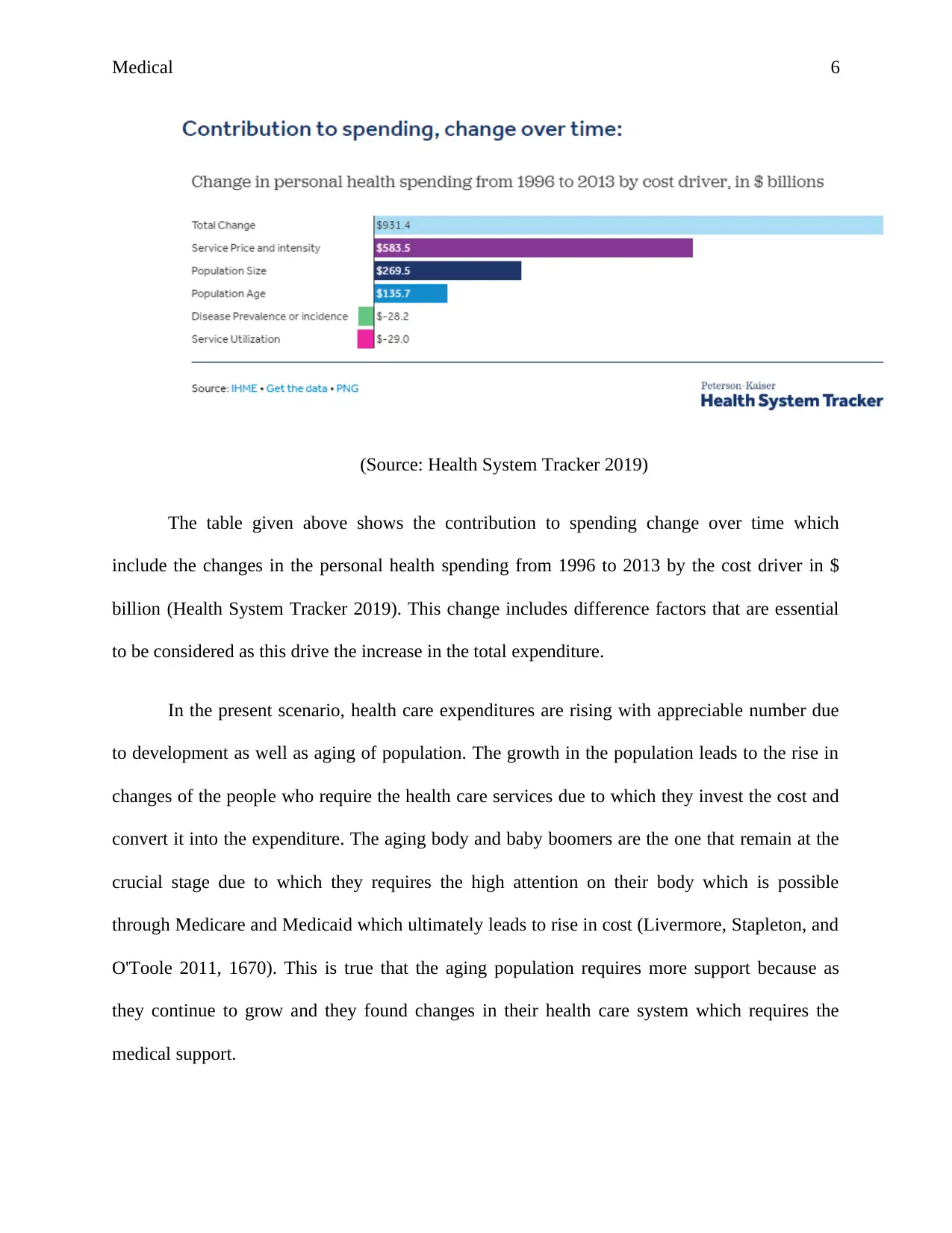
Medical 6
(Source: Health System Tracker 2019)
The table given above shows the contribution to spending change over time which
include the changes in the personal health spending from 1996 to 2013 by the cost driver in $
billion (Health System Tracker 2019). This change includes difference factors that are essential
to be considered as this drive the increase in the total expenditure.
In the present scenario, health care expenditures are rising with appreciable number due
to development as well as aging of population. The growth in the population leads to the rise in
changes of the people who require the health care services due to which they invest the cost and
convert it into the expenditure. The aging body and baby boomers are the one that remain at the
crucial stage due to which they requires the high attention on their body which is possible
through Medicare and Medicaid which ultimately leads to rise in cost (Livermore, Stapleton, and
O'Toole 2011, 1670). This is true that the aging population requires more support because as
they continue to grow and they found changes in their health care system which requires the
medical support.
(Source: Health System Tracker 2019)
The table given above shows the contribution to spending change over time which
include the changes in the personal health spending from 1996 to 2013 by the cost driver in $
billion (Health System Tracker 2019). This change includes difference factors that are essential
to be considered as this drive the increase in the total expenditure.
In the present scenario, health care expenditures are rising with appreciable number due
to development as well as aging of population. The growth in the population leads to the rise in
changes of the people who require the health care services due to which they invest the cost and
convert it into the expenditure. The aging body and baby boomers are the one that remain at the
crucial stage due to which they requires the high attention on their body which is possible
through Medicare and Medicaid which ultimately leads to rise in cost (Livermore, Stapleton, and
O'Toole 2011, 1670). This is true that the aging population requires more support because as
they continue to grow and they found changes in their health care system which requires the
medical support.
Paraphrase This Document
Need a fresh take? Get an instant paraphrase of this document with our AI Paraphraser
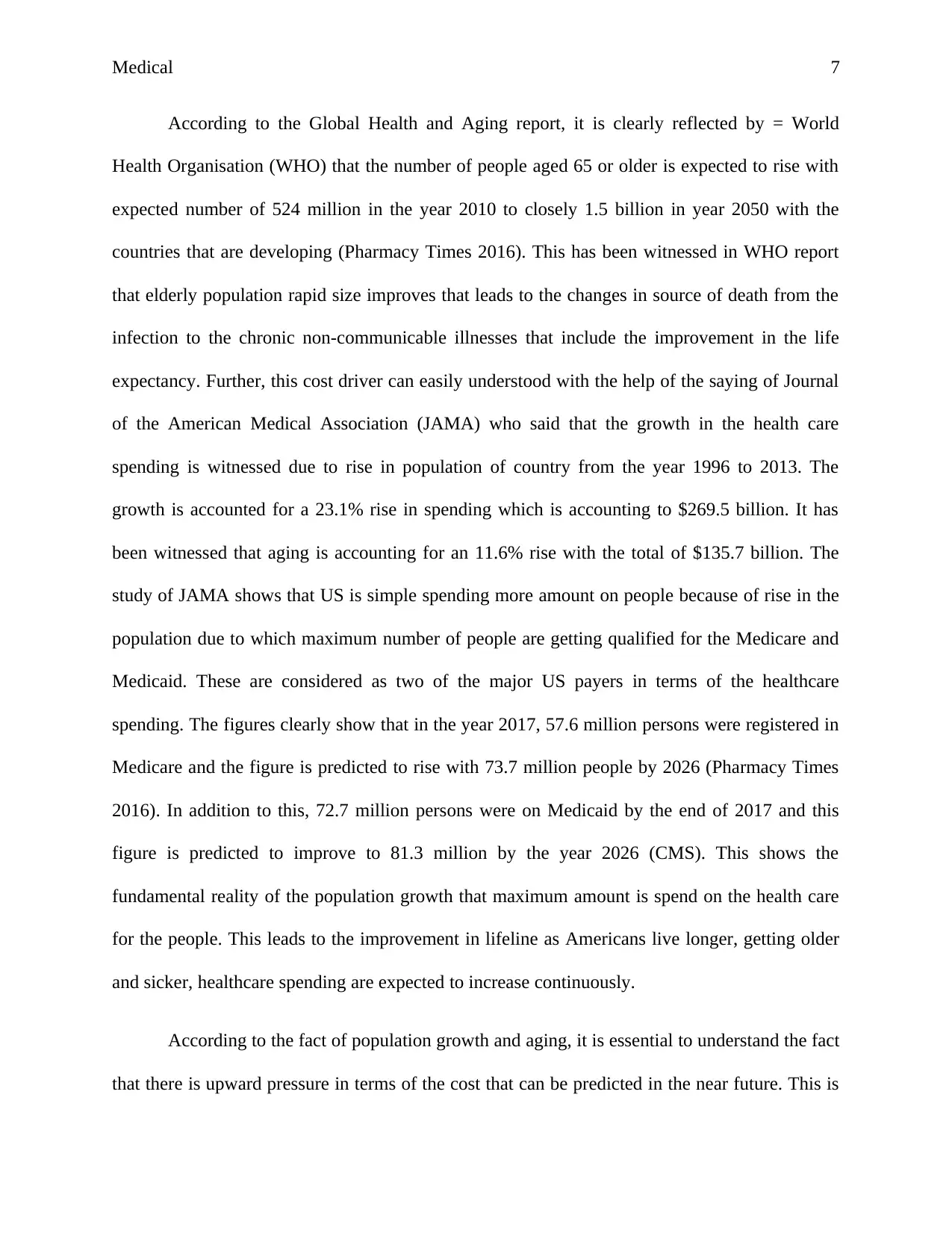
Medical 7
According to the Global Health and Aging report, it is clearly reflected by = World
Health Organisation (WHO) that the number of people aged 65 or older is expected to rise with
expected number of 524 million in the year 2010 to closely 1.5 billion in year 2050 with the
countries that are developing (Pharmacy Times 2016). This has been witnessed in WHO report
that elderly population rapid size improves that leads to the changes in source of death from the
infection to the chronic non-communicable illnesses that include the improvement in the life
expectancy. Further, this cost driver can easily understood with the help of the saying of Journal
of the American Medical Association (JAMA) who said that the growth in the health care
spending is witnessed due to rise in population of country from the year 1996 to 2013. The
growth is accounted for a 23.1% rise in spending which is accounting to $269.5 billion. It has
been witnessed that aging is accounting for an 11.6% rise with the total of $135.7 billion. The
study of JAMA shows that US is simple spending more amount on people because of rise in the
population due to which maximum number of people are getting qualified for the Medicare and
Medicaid. These are considered as two of the major US payers in terms of the healthcare
spending. The figures clearly show that in the year 2017, 57.6 million persons were registered in
Medicare and the figure is predicted to rise with 73.7 million people by 2026 (Pharmacy Times
2016). In addition to this, 72.7 million persons were on Medicaid by the end of 2017 and this
figure is predicted to improve to 81.3 million by the year 2026 (CMS). This shows the
fundamental reality of the population growth that maximum amount is spend on the health care
for the people. This leads to the improvement in lifeline as Americans live longer, getting older
and sicker, healthcare spending are expected to increase continuously.
According to the fact of population growth and aging, it is essential to understand the fact
that there is upward pressure in terms of the cost that can be predicted in the near future. This is
According to the Global Health and Aging report, it is clearly reflected by = World
Health Organisation (WHO) that the number of people aged 65 or older is expected to rise with
expected number of 524 million in the year 2010 to closely 1.5 billion in year 2050 with the
countries that are developing (Pharmacy Times 2016). This has been witnessed in WHO report
that elderly population rapid size improves that leads to the changes in source of death from the
infection to the chronic non-communicable illnesses that include the improvement in the life
expectancy. Further, this cost driver can easily understood with the help of the saying of Journal
of the American Medical Association (JAMA) who said that the growth in the health care
spending is witnessed due to rise in population of country from the year 1996 to 2013. The
growth is accounted for a 23.1% rise in spending which is accounting to $269.5 billion. It has
been witnessed that aging is accounting for an 11.6% rise with the total of $135.7 billion. The
study of JAMA shows that US is simple spending more amount on people because of rise in the
population due to which maximum number of people are getting qualified for the Medicare and
Medicaid. These are considered as two of the major US payers in terms of the healthcare
spending. The figures clearly show that in the year 2017, 57.6 million persons were registered in
Medicare and the figure is predicted to rise with 73.7 million people by 2026 (Pharmacy Times
2016). In addition to this, 72.7 million persons were on Medicaid by the end of 2017 and this
figure is predicted to improve to 81.3 million by the year 2026 (CMS). This shows the
fundamental reality of the population growth that maximum amount is spend on the health care
for the people. This leads to the improvement in lifeline as Americans live longer, getting older
and sicker, healthcare spending are expected to increase continuously.
According to the fact of population growth and aging, it is essential to understand the fact
that there is upward pressure in terms of the cost that can be predicted in the near future. This is
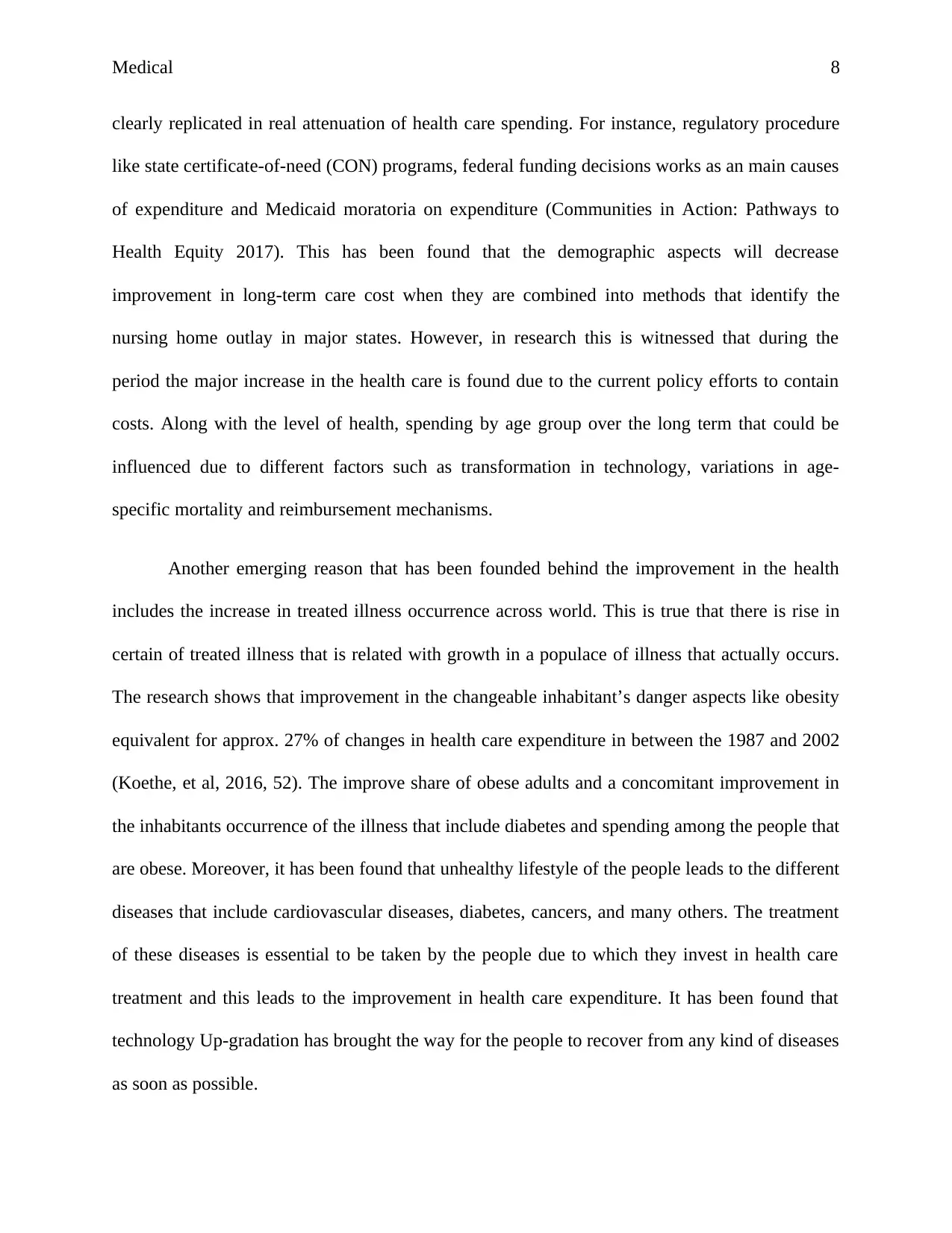
Medical 8
clearly replicated in real attenuation of health care spending. For instance, regulatory procedure
like state certificate-of-need (CON) programs, federal funding decisions works as an main causes
of expenditure and Medicaid moratoria on expenditure (Communities in Action: Pathways to
Health Equity 2017). This has been found that the demographic aspects will decrease
improvement in long-term care cost when they are combined into methods that identify the
nursing home outlay in major states. However, in research this is witnessed that during the
period the major increase in the health care is found due to the current policy efforts to contain
costs. Along with the level of health, spending by age group over the long term that could be
influenced due to different factors such as transformation in technology, variations in age-
specific mortality and reimbursement mechanisms.
Another emerging reason that has been founded behind the improvement in the health
includes the increase in treated illness occurrence across world. This is true that there is rise in
certain of treated illness that is related with growth in a populace of illness that actually occurs.
The research shows that improvement in the changeable inhabitant’s danger aspects like obesity
equivalent for approx. 27% of changes in health care expenditure in between the 1987 and 2002
(Koethe, et al, 2016, 52). The improve share of obese adults and a concomitant improvement in
the inhabitants occurrence of the illness that include diabetes and spending among the people that
are obese. Moreover, it has been found that unhealthy lifestyle of the people leads to the different
diseases that include cardiovascular diseases, diabetes, cancers, and many others. The treatment
of these diseases is essential to be taken by the people due to which they invest in health care
treatment and this leads to the improvement in health care expenditure. It has been found that
technology Up-gradation has brought the way for the people to recover from any kind of diseases
as soon as possible.
clearly replicated in real attenuation of health care spending. For instance, regulatory procedure
like state certificate-of-need (CON) programs, federal funding decisions works as an main causes
of expenditure and Medicaid moratoria on expenditure (Communities in Action: Pathways to
Health Equity 2017). This has been found that the demographic aspects will decrease
improvement in long-term care cost when they are combined into methods that identify the
nursing home outlay in major states. However, in research this is witnessed that during the
period the major increase in the health care is found due to the current policy efforts to contain
costs. Along with the level of health, spending by age group over the long term that could be
influenced due to different factors such as transformation in technology, variations in age-
specific mortality and reimbursement mechanisms.
Another emerging reason that has been founded behind the improvement in the health
includes the increase in treated illness occurrence across world. This is true that there is rise in
certain of treated illness that is related with growth in a populace of illness that actually occurs.
The research shows that improvement in the changeable inhabitant’s danger aspects like obesity
equivalent for approx. 27% of changes in health care expenditure in between the 1987 and 2002
(Koethe, et al, 2016, 52). The improve share of obese adults and a concomitant improvement in
the inhabitants occurrence of the illness that include diabetes and spending among the people that
are obese. Moreover, it has been found that unhealthy lifestyle of the people leads to the different
diseases that include cardiovascular diseases, diabetes, cancers, and many others. The treatment
of these diseases is essential to be taken by the people due to which they invest in health care
treatment and this leads to the improvement in health care expenditure. It has been found that
technology Up-gradation has brought the way for the people to recover from any kind of diseases
as soon as possible.
⊘ This is a preview!⊘
Do you want full access?
Subscribe today to unlock all pages.

Trusted by 1+ million students worldwide
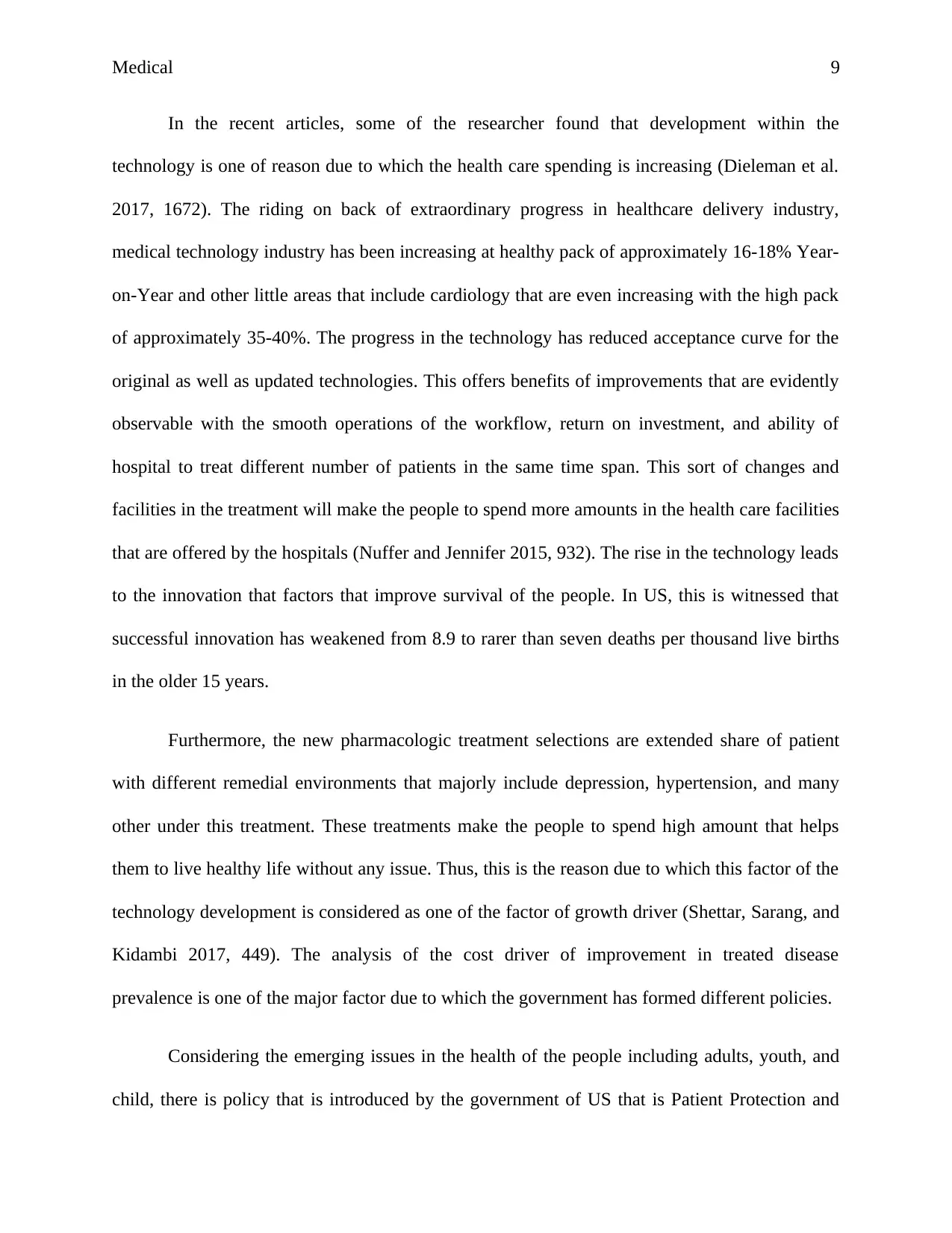
Medical 9
In the recent articles, some of the researcher found that development within the
technology is one of reason due to which the health care spending is increasing (Dieleman et al.
2017, 1672). The riding on back of extraordinary progress in healthcare delivery industry,
medical technology industry has been increasing at healthy pack of approximately 16-18% Year-
on-Year and other little areas that include cardiology that are even increasing with the high pack
of approximately 35-40%. The progress in the technology has reduced acceptance curve for the
original as well as updated technologies. This offers benefits of improvements that are evidently
observable with the smooth operations of the workflow, return on investment, and ability of
hospital to treat different number of patients in the same time span. This sort of changes and
facilities in the treatment will make the people to spend more amounts in the health care facilities
that are offered by the hospitals (Nuffer and Jennifer 2015, 932). The rise in the technology leads
to the innovation that factors that improve survival of the people. In US, this is witnessed that
successful innovation has weakened from 8.9 to rarer than seven deaths per thousand live births
in the older 15 years.
Furthermore, the new pharmacologic treatment selections are extended share of patient
with different remedial environments that majorly include depression, hypertension, and many
other under this treatment. These treatments make the people to spend high amount that helps
them to live healthy life without any issue. Thus, this is the reason due to which this factor of the
technology development is considered as one of the factor of growth driver (Shettar, Sarang, and
Kidambi 2017, 449). The analysis of the cost driver of improvement in treated disease
prevalence is one of the major factor due to which the government has formed different policies.
Considering the emerging issues in the health of the people including adults, youth, and
child, there is policy that is introduced by the government of US that is Patient Protection and
In the recent articles, some of the researcher found that development within the
technology is one of reason due to which the health care spending is increasing (Dieleman et al.
2017, 1672). The riding on back of extraordinary progress in healthcare delivery industry,
medical technology industry has been increasing at healthy pack of approximately 16-18% Year-
on-Year and other little areas that include cardiology that are even increasing with the high pack
of approximately 35-40%. The progress in the technology has reduced acceptance curve for the
original as well as updated technologies. This offers benefits of improvements that are evidently
observable with the smooth operations of the workflow, return on investment, and ability of
hospital to treat different number of patients in the same time span. This sort of changes and
facilities in the treatment will make the people to spend more amounts in the health care facilities
that are offered by the hospitals (Nuffer and Jennifer 2015, 932). The rise in the technology leads
to the innovation that factors that improve survival of the people. In US, this is witnessed that
successful innovation has weakened from 8.9 to rarer than seven deaths per thousand live births
in the older 15 years.
Furthermore, the new pharmacologic treatment selections are extended share of patient
with different remedial environments that majorly include depression, hypertension, and many
other under this treatment. These treatments make the people to spend high amount that helps
them to live healthy life without any issue. Thus, this is the reason due to which this factor of the
technology development is considered as one of the factor of growth driver (Shettar, Sarang, and
Kidambi 2017, 449). The analysis of the cost driver of improvement in treated disease
prevalence is one of the major factor due to which the government has formed different policies.
Considering the emerging issues in the health of the people including adults, youth, and
child, there is policy that is introduced by the government of US that is Patient Protection and
Paraphrase This Document
Need a fresh take? Get an instant paraphrase of this document with our AI Paraphraser
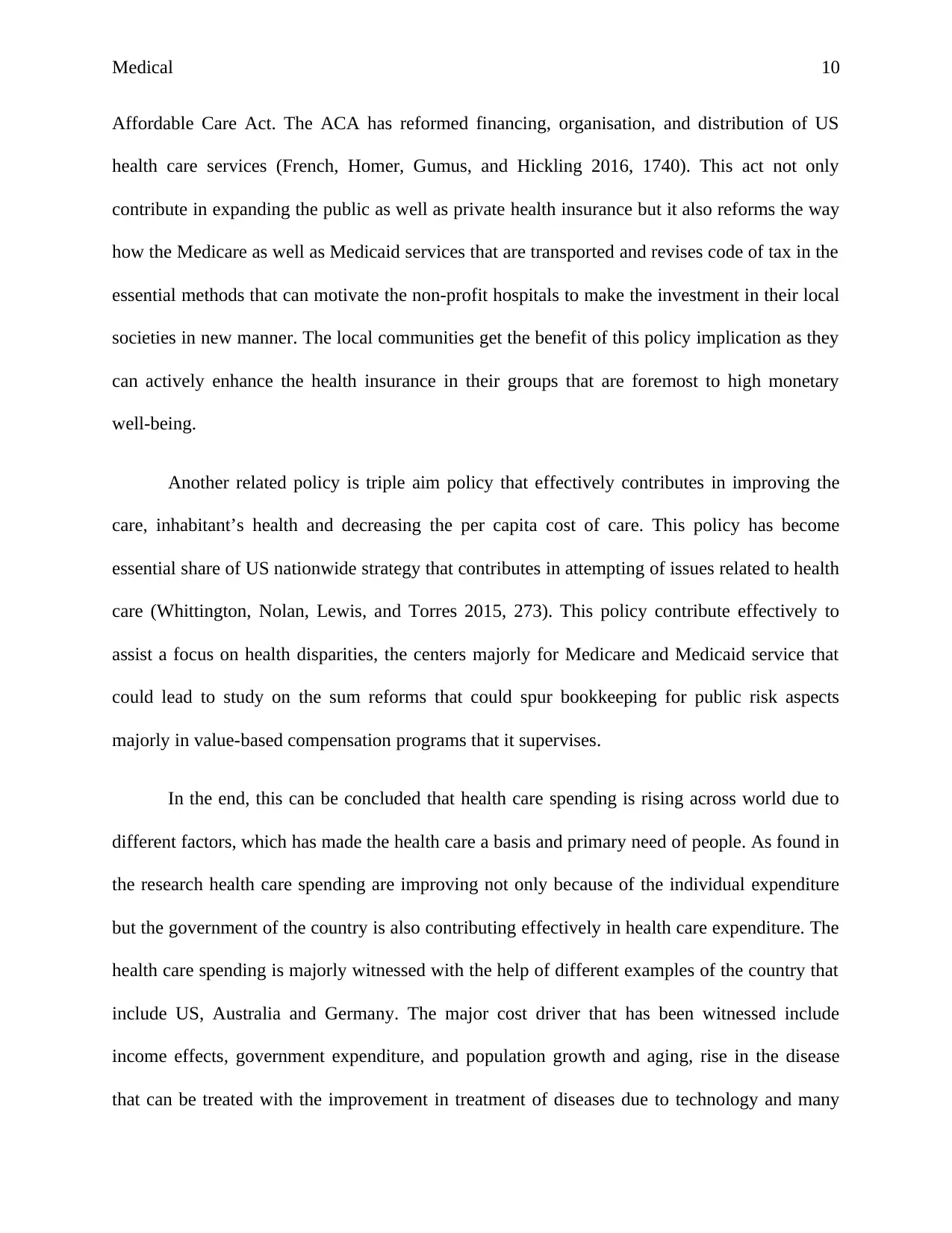
Medical 10
Affordable Care Act. The ACA has reformed financing, organisation, and distribution of US
health care services (French, Homer, Gumus, and Hickling 2016, 1740). This act not only
contribute in expanding the public as well as private health insurance but it also reforms the way
how the Medicare as well as Medicaid services that are transported and revises code of tax in the
essential methods that can motivate the non-profit hospitals to make the investment in their local
societies in new manner. The local communities get the benefit of this policy implication as they
can actively enhance the health insurance in their groups that are foremost to high monetary
well-being.
Another related policy is triple aim policy that effectively contributes in improving the
care, inhabitant’s health and decreasing the per capita cost of care. This policy has become
essential share of US nationwide strategy that contributes in attempting of issues related to health
care (Whittington, Nolan, Lewis, and Torres 2015, 273). This policy contribute effectively to
assist a focus on health disparities, the centers majorly for Medicare and Medicaid service that
could lead to study on the sum reforms that could spur bookkeeping for public risk aspects
majorly in value-based compensation programs that it supervises.
In the end, this can be concluded that health care spending is rising across world due to
different factors, which has made the health care a basis and primary need of people. As found in
the research health care spending are improving not only because of the individual expenditure
but the government of the country is also contributing effectively in health care expenditure. The
health care spending is majorly witnessed with the help of different examples of the country that
include US, Australia and Germany. The major cost driver that has been witnessed include
income effects, government expenditure, and population growth and aging, rise in the disease
that can be treated with the improvement in treatment of diseases due to technology and many
Affordable Care Act. The ACA has reformed financing, organisation, and distribution of US
health care services (French, Homer, Gumus, and Hickling 2016, 1740). This act not only
contribute in expanding the public as well as private health insurance but it also reforms the way
how the Medicare as well as Medicaid services that are transported and revises code of tax in the
essential methods that can motivate the non-profit hospitals to make the investment in their local
societies in new manner. The local communities get the benefit of this policy implication as they
can actively enhance the health insurance in their groups that are foremost to high monetary
well-being.
Another related policy is triple aim policy that effectively contributes in improving the
care, inhabitant’s health and decreasing the per capita cost of care. This policy has become
essential share of US nationwide strategy that contributes in attempting of issues related to health
care (Whittington, Nolan, Lewis, and Torres 2015, 273). This policy contribute effectively to
assist a focus on health disparities, the centers majorly for Medicare and Medicaid service that
could lead to study on the sum reforms that could spur bookkeeping for public risk aspects
majorly in value-based compensation programs that it supervises.
In the end, this can be concluded that health care spending is rising across world due to
different factors, which has made the health care a basis and primary need of people. As found in
the research health care spending are improving not only because of the individual expenditure
but the government of the country is also contributing effectively in health care expenditure. The
health care spending is majorly witnessed with the help of different examples of the country that
include US, Australia and Germany. The major cost driver that has been witnessed include
income effects, government expenditure, and population growth and aging, rise in the disease
that can be treated with the improvement in treatment of diseases due to technology and many
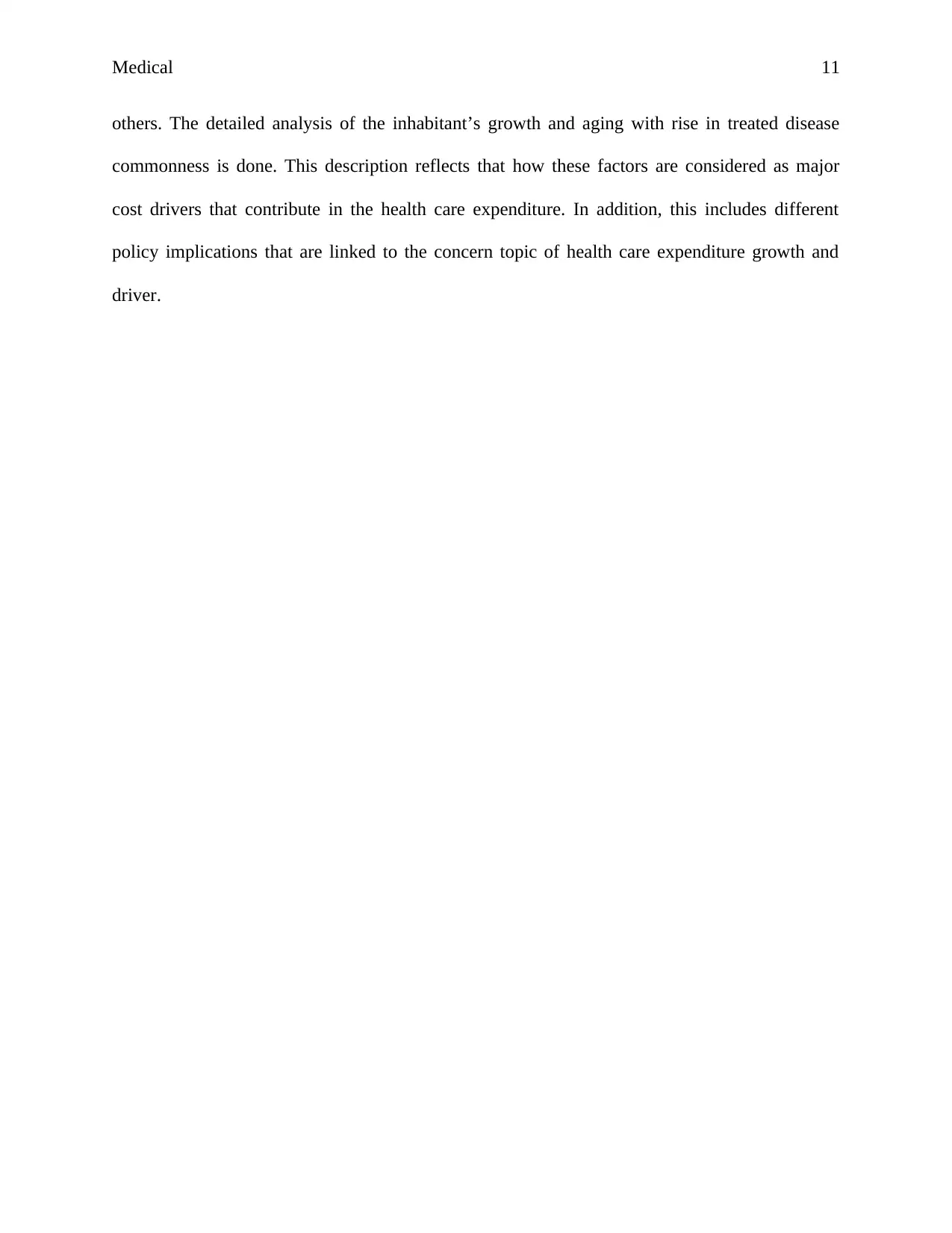
Medical 11
others. The detailed analysis of the inhabitant’s growth and aging with rise in treated disease
commonness is done. This description reflects that how these factors are considered as major
cost drivers that contribute in the health care expenditure. In addition, this includes different
policy implications that are linked to the concern topic of health care expenditure growth and
driver.
others. The detailed analysis of the inhabitant’s growth and aging with rise in treated disease
commonness is done. This description reflects that how these factors are considered as major
cost drivers that contribute in the health care expenditure. In addition, this includes different
policy implications that are linked to the concern topic of health care expenditure growth and
driver.
⊘ This is a preview!⊘
Do you want full access?
Subscribe today to unlock all pages.

Trusted by 1+ million students worldwide
1 out of 16
Related Documents
Your All-in-One AI-Powered Toolkit for Academic Success.
+13062052269
info@desklib.com
Available 24*7 on WhatsApp / Email
![[object Object]](/_next/static/media/star-bottom.7253800d.svg)
Unlock your academic potential
Copyright © 2020–2025 A2Z Services. All Rights Reserved. Developed and managed by ZUCOL.





